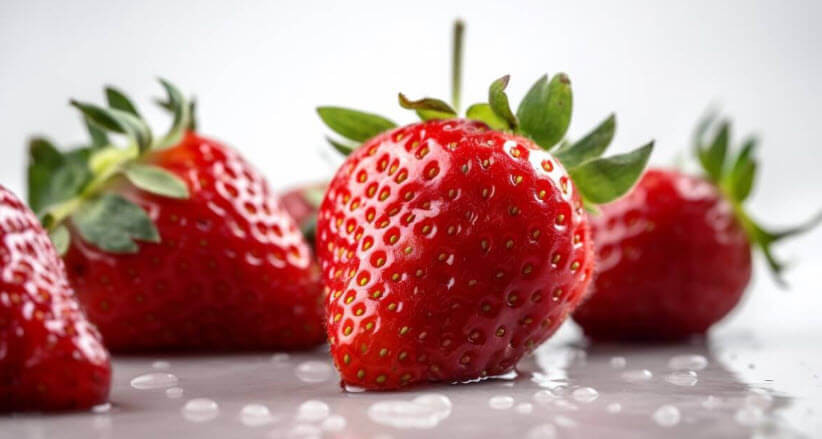Would you prefer to listen to a short podcast discussion about this article? Click on the audio below.
If you're looking for a sweet and juicy addition to your garden, strawberries can be an excellent choice. These delicious and nutritious fruits are relatively easy to grow, and with the right care, you can enjoy a bountiful harvest of fresh berries each year.
Table of Contents
Whether you're a seasoned gardener or a beginner, this article will guide you through the process of growing strawberries. We'll cover everything from choosing the best varieties for your climate to preparing your soil, planting and caring for your plants, and harvesting and storing your crop. We'll also discuss common pests and diseases that can affect UK strawberry plants and provide tips for preventing and managing these issues. So, let's get started and discover how to grow great strawberries!
1. Choosing the Right Location for Strawberry Plants
When growing strawberries, it's essential to choose the right location for your plant. Here are the key things to consider:
Determining the Best Sun Exposure for Strawberry Plants
Strawberries need plenty of sunlight to grow. Therefore, it's best to plant them in an area that receives at least six hours of direct sunlight per day. If your garden doesn't receive enough sunlight, consider planting them in containers that you can move to a sunnier spot throughout the day.
Identifying the Ideal Soil pH for Growing Strawberries in the UK
Strawberries prefer slightly acidic soil with a pH range between 5.5 and 6.5. You can test your soil's pH using a home testing kit or through a professional soil testing service. If your soil is too alkaline, you can add sulfur or peat moss to lower the pH level. Alternatively, you can raise the soil's pH level with lime if it's too acidic.
Optimizing Drainage to Prevent Waterlogged Soil
Strawberries like well-draining soil, so it's essential to avoid planting them in waterlogged soil. To improve drainage, add organic matter like compost, bark chips, or perlite to the soil. Additionally, you can plant your strawberries in raised beds or containers with drainage holes to prevent water accumulation.
2. Preparing the Soil for Optimal Strawberry Growth
Before planting your strawberries, it's important to prepare the soil properly. Here's what you need to do:
Clearing the Soil of Weeds and Debris
Remove any weeds and debris from the planting area to avoid competition for nutrients and water. You can use a hoe or garden fork to dig out any weeds and rake the surface clean.
Adding Organic Matter to Improve Soil Structure and Nutrient Levels
Add organic matter like compost or well-rotted manure to the soil to improve soil structure and fertility. Organic matter also helps retain moisture and prevent soil erosion.
Testing Soil Nutrient Levels and Adjusting As Needed
Test your soil to find out the nutrient levels. Based on the test results, amend the soil with lime, bone meal, or other fertilizers as needed.
3. Selecting the Best Varieties of Strawberries for Your Garden
Choosing the right strawberry varieties is crucial to ensure a bountiful harvest. Here are the factors to consider:
Understanding the Different Types of Strawberries
There are three main types of strawberries: June-bearing, Everbearing, and Day-neutral. June-bearing strawberries produce fruit only once a year in late spring or early summer. Everbearing strawberries produce two or three harvests throughout the growing season, while Day-neutral strawberries produce fruit throughout the growing season.
Choosing Strawberries for Best Flavor and Yield in the UK Climate
When selecting strawberry varieties, choose ones that perform well in the UK climate. Some popular UK strawberry varieties include Elsanta, Malling Centenary, Cambridge Favourite, and Honeoye. These varieties have excellent flavour and high yields in the UK climate.
Considering Disease Resistance and Tolerance to UK Weather Conditions
Choose strawberry varieties that are resistant to common UK diseases like powdery mildew, verticillium wilt, and leaf spot. Additionally, choose varieties that are tolerant to cool and wet weather conditions that are typical in the UK.

4. Planting and Caring for Strawberry Plants
After you have prepared the soil and chosen the right varieties of strawberries, you're ready to plant and care for your plants:
When to Plant Strawberries
Plant strawberries in the UK in late summer or early fall. This gives the plants time to establish themselves before the winter frost. Alternatively, you can plant in early spring after the danger of frost has passed.
Proper Technique for Planting Strawberry Seedlings
When planting strawberry seedlings, dig small holes in the soil with a trowel. Place the roots of the plant gently in the hole and cover them with soil up to the crown of the plant. Be careful not to bury the crown in the soil, as this can lead to rotting.
Watering, Mulching, and Supporting Strawberry Plants
Water your strawberry plants regularly, especially during dry periods. Mulch the plants with straw, leaves, or other organic matter to retain moisture and suppress weed growth. Additionally, support the plants with stakes or netting to prevent them from falling over due to the weight of the fruit.
8. Conclusion
Final Thoughts and Recap of Key Points for Growing Strawberries Successfully
5. Best Practices for Fertilizing and Watering
How to Fertilize Strawberry Plants for Optimal Growth and Fruit Production
Strawberries are heavy feeders that require regular fertilization for optimal growth and fruit production. Before planting, add compost or well-rotted manure to the soil to provide nutrients. During the growing season, fertilize every two weeks with a balanced, water-soluble fertilizer. Avoid over-fertilizing, as this can lead to excessive foliage growth, at the expense of fruit production.
Watering Strawberry Plants to Prevent Drought Stress and Waterlogging
Strawberries need consistent moisture but don't like waterlogged soil. Water deeply once a week, and more often during hot and dry weather. Avoid overhead watering, which can lead to fungal diseases. Instead, use drip irrigation or soaker hoses to deliver water directly to the roots.
Tips for Using Drip Irrigation and Other Efficient Watering Techniques
Drip irrigation is the most efficient way to water strawberries, as it delivers water directly to the plant's roots without wasting water through evaporation or runoff. Use a timer to ensure consistent watering and avoid over or under-watering. Other efficient watering techniques include using a watering can with a long spout to deliver water directly to the base of each plant and mulching with straw or other organic material to retain moisture.
6. Harvesting and Storing Strawberries
When to Harvest Strawberries for Best Flavor and Texture
Harvest strawberries when they are fully ripe for the best flavour and texture. Look for berries that are bright red, plump, and fragrant. Remove the berries by gently twisting them at the stem, being careful not to damage the plant or surrounding fruit.
Proper Technique for Picking Strawberries to Avoid Damaging the Fruit
To avoid damaging the fruit, always handle strawberries gently when picking them. Use two hands to hold the stem, and gently twist the berry to remove it. Be careful not to squeeze or crush the berries, as this can lead to bruising and spoilage.
Tips for Storing Fresh Strawberries to Extend Shelf Life
Freshly picked strawberries are best eaten within a few days, but they can be stored for up to a week in the refrigerator. Store unwashed strawberries in a single layer on a paper towel-lined tray or in a breathable container. Wash strawberries just before using them to avoid moisture buildup that can lead to spoilage.
7. Preventing and Managing Common Strawberry Plant Pests and Diseases
Identifying Common Pests and Diseases That Affect UK Strawberry Plants
Common pests that attack strawberry plants in the UK include aphids, spider mites, slugs, and snails. Common diseases include grey mould, powdery mildew, and verticillium wilt. Look for signs of damage such as yellowing or wilting leaves, chewed leaves or stems or discoloured fruit.
Preventing Pests and Diseases Through Good Cultural Practices and Plant Selection
Preventing pest and disease problems starts with good cultural practices such as rotating crops and keeping the area free of weeds and debris. Choose disease-resistant cultivars and keep the plants healthy with regular fertilization and watering. Natural predators such as ladybugs and lacewings can also help control pests.
Treating Common Pests and Diseases with Organic and Chemical Methods
Organic methods such as companion planting and introducing beneficial insects can help control pests and diseases. Neem oil and insecticidal soap can be used to treat aphids and spider mites, while slug and snail baits can control these pests. Fungicides may be necessary for treating fungal diseases such as grey mould or powdery mildew.
8. Conclusion
Final Thoughts and Recap of Key Points for Growing Strawberries Successfully
Growing strawberries can be a rewarding and delicious experience with the proper care and attention. Remember to fertilize and water regularly, harvest ripe fruit carefully, and manage pests and diseases using good cultural practices and appropriate treatments. With a little effort and patience, you can enjoy a bumper crop of sweet, juicy strawberries in your garden or allotment.
Growing strawberries can be a rewarding and enjoyable experience for any gardener. By following these tips for choosing the right location, preparing the soil, selecting the best varieties, and caring for your plants, you can produce a bountiful harvest of sweet and juicy strawberries. Remember to always pay attention to your plants and stay vigilant for signs of pests or diseases. With a little patience and effort, you'll have a delicious and nutritious crop of strawberries to enjoy for years to come.
FAQ
1. When is the best time to plant strawberries?
The best time to plant strawberries in the UK is in early spring, usually from March to early May. This allows the plants to establish themselves before the summer heat sets in.
2. What is the best way to water strawberry plants?
Strawberry plants need consistent moisture to thrive, but it's important not to overwater them. The best way to water strawberry plants is to use a soaker hose or a drip irrigation system. This allows the water to soak deeply into the soil without wetting the leaves, which can lead to disease.
3. How can I prevent pests and diseases from damaging my strawberry plants?
Preventing pests and diseases in your strawberry plants is essential to ensure a healthy crop. To prevent pests, you can use row covers or insecticidal soap. To prevent diseases, avoid overwatering and overcrowding your plants. It's also important to remove any diseased leaves or fruit from the plants as soon as you notice them.
4. What are some common varieties of strawberries grown?
Some common varieties of strawberries grown in the UK include 'Elsanta', 'Malling Centenary', 'Cambridge Favourite', and 'Honeoye'. Each variety has its own unique characteristics, such as flavour, yield, and disease resistance, so be sure to choose the one that's best suited to your growing conditions and preferences.
If you are keen on organic gardening, check out The Soil Association website
If you need any further information or assistance with this article, don't hesitate to Contact Us




















